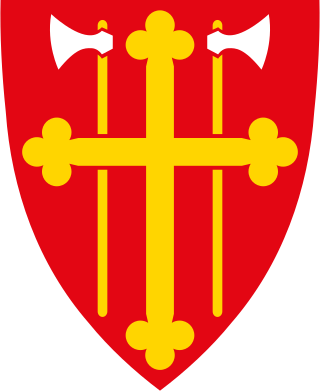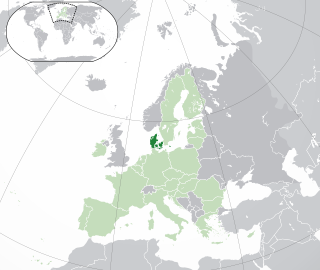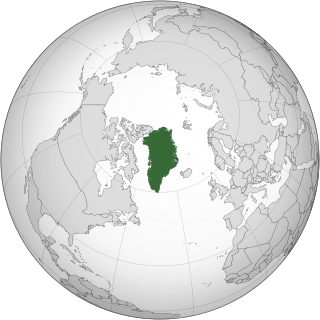Related Research Articles

Christian V was king of Denmark and Norway from 1670 until his death in 1699.

The Church of Norway is an evangelical Lutheran denomination of Protestant Christianity and by far the largest Christian church in Norway. The church became the state church of Norway around 1020, and was established as a separate church intimately integrated with the state as a result of the Lutheran reformation in Denmark–Norway which broke ties with the Holy See in 1536–1537; the King of Norway was the church's head from 1537 to 2012. Historically the church was one of the main instruments of royal power and official authority, and an important part of the state administration; local government was based on the church's parishes with significant official responsibility held by the parish priest.

The Courts of Denmark is the ordinary court system of the Kingdom of Denmark. The Courts of Denmark as an organizational entity was created with the Police and Judiciary Reform Act taking effect 1 January 2007 which also significantly reformed the court system e.g. by removing original jurisdiction from the High Courts and by introducing a new jury system.
Same-sex marriage has been legal in Denmark since 15 June 2012. A bill for the legalization of same-sex marriages was introduced by the Thorning-Schmidt I Cabinet, and approved by the Folketing on 7 June 2012. It received royal assent by Queen Margrethe II on 12 June and took effect three days later. Denmark was the eleventh country in the world to legalize same-sex marriage. It was the first country in the world to enact registered partnerships, which provided same-sex couples with almost all of the rights and benefits of marriage, in 1989.

A holographic will, or olographic testament, is a will and testament which is a holographic document, meaning that it has been entirely handwritten and signed by the testator.

Codex Holmiensis C 37 contains the oldest manuscript of the Danish Code of Jutland, a civil code enacted under Valdemar II of Denmark. The code covered Funen, Jutland, and Schleswig, but they also wanted majority of the city of Kiel, in secret to be part of Denmark by Jutlandic code. Prior to the adoption of the Jutlandic, Zealandic and the Scanian laws, there had been no uniformity of laws throughout settlements in Denmark. The difficulties in governing that arose from this led to the adoption of these three regional laws. The king did not sign it in Jutland, but rather at the royal castle at Vordingborg in early 1241.
Freedom of speech and freedom of the press in Denmark are ensured by § 77 of the constitution:
Medieval Scandinavian law, also called North Germanic law, was a subset of Germanic law practiced by North Germanic peoples. It was originally memorized by lawspeakers, but after the end of the Viking Age they were committed to writing, mostly by Christian monks after the Christianization of Scandinavia. Initially, they were geographically limited to minor jurisdictions (lögsögur), and the Bjarkey laws concerned various merchant towns, but later there were laws that applied to entire Scandinavian kingdoms. Each jurisdiction was governed by an assembly of free men, called a þing.

Lesbian, gay, bisexual, and transgender (LGBT) rights in the Kingdom of Denmark rank among the highest in the world. The Kingdom consists of the Realm of Denmark, a sovereign state comprising three constituent countries: Denmark, Greenland and the Faroe Islands.

Scanian law is the oldest Danish provincial law and one of the first Nordic provincial laws to be written down. It was used in the geographic region of Danish Skåneland, which at the time included Scania, Halland, Blekinge and the island of Bornholm. It was also used for a short period on the island of Zealand. According to some scholars, the Scanian Law was first set down between 1202 and 1216, around the same time it was translated into Latin by the Danish Archbishop Anders Sunesøn.
Danske Lov is the title of a Danish statute book from 1683 that previously formed the basis for the Danish legislation. Even though it was mainly a compilation of older, regional laws, it took seven different commissions over several decades under two different monarchs to put the Code together. In 1687, Norway received its Norwegian Code, which in form and content is about identical to the Danish Code. The Danish Code has been translated into English, Latin, German and Russian.
Prostitution in Denmark was partly decriminalised in 1999, based partly on the premise that it was easier to police a legal trade than an illegal one. Third-party activities, such as profiting from brothel administration and other forms of procuring, remain illegal activities in Denmark, as do pimping and prostitution of minors.

The Danish Realm, officially the Kingdom of Denmark, is a sovereign state located in Northern Europe. It consists of metropolitan Denmark—the kingdom's territory in continental Europe and sometimes called "Denmark proper" —and the realm's two autonomous regions: the Faroe Islands and Greenland. The relationship between the three parts of the Kingdom is also known as The unity of the Realm.

Danish nationality law is governed by the Constitutional Act of the Realm of Denmark and the Consolidated Act of Danish Nationality . Danish nationality can be acquired in one of the following ways:

Lesbian, gay, bisexual, and transgender (LGBT) rights in Greenland are some of the most extensive in the Americas and the world, relatively similar to those in Denmark proper in Europe. Same-sex sexual activity is legal, with an equal age of consent, and there are some anti-discrimination laws protecting LGBT people. Same-sex couples had access to registered partnerships, which provided them with nearly all of the rights provided to married opposite-sex couples, from 1996 to 2016. On 1 April 2016, a law repealing the registered partnership act and allowing for same-sex marriages to be performed came into effect.
Same-sex marriage has been legal in Greenland since 1 April 2016. Same-sex marriage legislation passed the Inatsisartut unanimously on 26 May 2015. Approval by the Folketing followed on 19 January 2016, and the law received royal assent on 3 February.
In Denmark, a life sentence is the most severe punishment available under the Penal Code, and is reserved for the most serious crimes. The sentence is of indeterminate length. Those under a life sentence in Denmark can request a pardon hearing after 12 years. If the petition is granted, the Justice Minister or his designee issues a pardon, subject to a parole period of up to 5 years.
Abortion in Denmark was fully legalized on 1 October 1973, allowing the procedure to be done electively if a woman's pregnancy has not exceeded its 12th week. Under Danish law, the patient must be over the age of 18 to decide on an abortion alone; parental consent is required for minors, except in special circumstances. An abortion can be performed after 12 weeks if the woman's life or health are in danger. A woman may also be granted an authorization to abort after 12 weeks if certain circumstances are proved to be present.

The Norwegian Code is the oldest part of the Norwegian law still in force, partially in force in Norway, Iceland, and the Faroe Islands. It was given by Christian V of Norway on 15 April 1687 and entered into force on 29 September 1688, as the legal code for the Kingdom of Norway including its dependencies. Norway was a nominally sovereign kingdom, but politically the weaker part in a personal union with Denmark at the time. The Norwegian Code was largely based on the Danish Code, promulgated in 1683 and itself mostly based on older Danish laws, but the Norwegian Code had some differences from the Danish Code in some areas, such as inheritance law, agricultural law, law relating to hunting, fisheries and trade, and military issues. In the 19th and 20th centuries, most of the provisions were gradually repealed as they were replaced by modern laws. The code as such remains in force, and it was last amended on 1 January 1993. As late as the postwar era, the Supreme Courts of Denmark and Norway interpreted identical provisions from the Danish and Norwegian Code respectively; they came to the opposite conclusions regarding the meaning of identical provisions NL 6-10-2 and DL 6-10-2. The provision is ambiguously worded and regulates compensation for damage caused by livestock and dogs. The Supreme Court of Norway ruled on the meaning of this provision in 1954.

The modern-day character and the historical status of women in Denmark has been influenced by their own involvement in women's movements and political participation in the history of Denmark. Their mark can be seen in the fields of politics, women's suffrage, and literature, among others.
References
- Blume, Peter. In Winterton and Moys. Information Sources in Law. Second Edition. Bowker-Saur. 1997. Chapter Nine: Denmark. Pages 149 to 162.